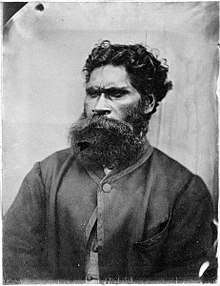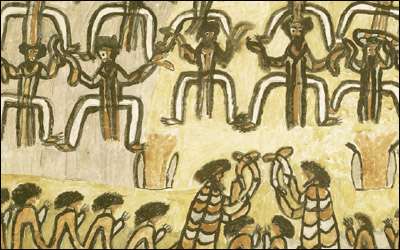William Barak
William Barak (or Beruk) (c. 1824 – 15 August 1903), was a traditional ngurungaeta (elder) of the Wurundjeri-willam clan, first inhabitants of present-day Melbourne, Australia. He became an influential spokesman for Aboriginal social justice and an important informant on Wurundjeri cultural lore.

Biography
Barak was born in the early 1820s at Brushy Creek near present-day Croydon, in the country of the Wurundjeri people. His mother, Tooterrie, came from the Nourailum bulluk at Murchison, Victoria. His father, Bebejern, was an important member of the Wurundjeri clan. Barak was said to have been present as a boy when John Batman met with the tribal elders to "purchase" the Melbourne area in 1835.[1] Before he died he described witnessing the signing of the treaty in a ceremony he called a tanderem.
Ninggalobin, Poleorong and Billibellary were the leading song makers and principal Wurundjeri leaders in the Melbourne region. European colonisation had caused disruptions to initiation ceremonies. In response these three men gathered at South Yarra in the late 1830s and inducted the young Barak into Aboriginal lore. This entailed formally presenting him with the symbols of manhood: strips of possum skin tied around his biceps; the gombert (reed necklace) around his neck; given his ilbi-jerri, a sharp and narrow bone or nose-peg; and his branjep, the apron worn by men to cover their genitals. At the end of the ceremony Barak presented his uncle, Billibellary, a possumskin cloak.[2]
Barak attended the government’s Yarra Mission School from 1837 to 1839.
When he joined the Native Mounted Police in 1844, he was given the name of William Barak. He was Police Trooper No.19.
In early 1863, Barak moved to Coranderrk Station, near Healesville, Victoria with about thirty others.
Upon the death of Simon Wonga in 1875, Barak became the Ngurungaeta of the clan. He worked tirelessly for his people and was a successful negotiator on their behalf. He was a highly respected man and leader, with standing amongst the Indigenous people and the European settlers.[3]
Barak died at Coranderrk in 1903 and is buried at the Coranderrk cemetery. He was about 85 years old.[4]
Legacy


Barak is remembered for his artworks, which show both traditional Indigenous life and encounters with Europeans. Most of Barak's drawings were completed at Coranderrk during the 1880s and 1890s. They are now highly prized and exhibited in leading public galleries in Australia. His work is on permanent display in the National Gallery of Victoria Ian Potter Centre at Federation Square, Melbourne.[5] Ceremony (1895) is housed at the Ballarat Fine Art Gallery.[6]
In 2003 the National Gallery of Victoria held an exhibiton Remembering Barak to commemorate his life and work.[7] An education resource was developed to accompany the exhibtion.[8]
In 2004 Nillumbik Shire Council registered the place name Barak Bushlands, previously known as the Falkiner Street Reserve, along the Diamond Creek in Eltham.[9]
In 2005 a 525-metre footbridge called the "William Barak bridge" was constructed stretching from Birrarung Marr to the MCG, improving the link between some of Melbourne's biggest sports and entertainment venues and the heart of the CBD. In 2006 a permanent sound installation called "Proximities" was installed on the bridge. It was designed by David Chesworth and Sonia Leber. Its central section features a welcome song sung in Woiwurrung by Wurundjeri Elder, and Barak's descendant, Joy Murphy Wandin.
In 2011 Barak was inducted on to the Victorian Aboriginal Heritage Roll.[10]
In 2015 a 279-foot-tall (85-metre-tall) image of Barak was used to form the facade of an apartment building called Swanston Square in Melbourne, Australia. The portrait is formed by the white balconies against a black wall.[11]
References
- "A KING AT CORANDERRK". The Australasian. LXIII (1656). Victoria, Australia. 25 December 1897. p. 25. Retrieved 25 May 2016 – via National Library of Australia.
- Isabel Ellender and Peter Christiansen, pp52, People of the Merri Merri. The Wurundjeri in Colonial Days, Merri Creek Management Committee, 2001 ISBN 0-9577728-0-7
- "KING WILLIAM BARAK". The Australasian. LXXV (1951). Victoria, Australia. 22 August 1903. p. 32. Retrieved 25 May 2016 – via National Library of Australia.
- "DEATH OF KING WILLIAM BARAK". The Age (15, 113). Victoria, Australia. 17 August 2000. p. 4. Retrieved 25 May 2016 – via National Library of Australia.
- "William Barak | Artists | NGV". www.ngv.vic.gov.au. Retrieved 27 May 2020.
- "Ceremony; William BARAK; Circa 1895; 1934.5 on eHive". eHive. Retrieved 27 May 2020.
- "Remembering Barak | NGV". www.ngv.vic.gov.au. Retrieved 27 May 2020.
- "Remembering Barak: Education Resource" (PDF). National Gallery of Victoria. Retrieved 27 May 2020.
- "Notice of Registration of Geographic Names" (PDF). Victorian Government Gazette. 15 April 2004.
- "William Barak". www.aboriginalvictoria.vic.gov.au. 30 September 2019. Retrieved 27 May 2020.
- Portrait of indigenous leader etched into 31-storey Melbourne building, 4 March 2015, retrieved 24 May 2016
External links
- Remembering Barak at the National Gallery of Victoria.
- Joy Murphy-Wandin speaking about her great, great uncle.
- Ceremony – Ballarat Fine Art Gallery
- Joy Murphy-Wandin speaking about Barak and Coranderrk.
- William Barak, story on Culture Victoria
- William Barak News at the Aboriginal Art Directory
- William Barak 1823-1903
- A Contextual Understanding of ‘My Words’ by William Barak
- Tracing Victoria: William Barak